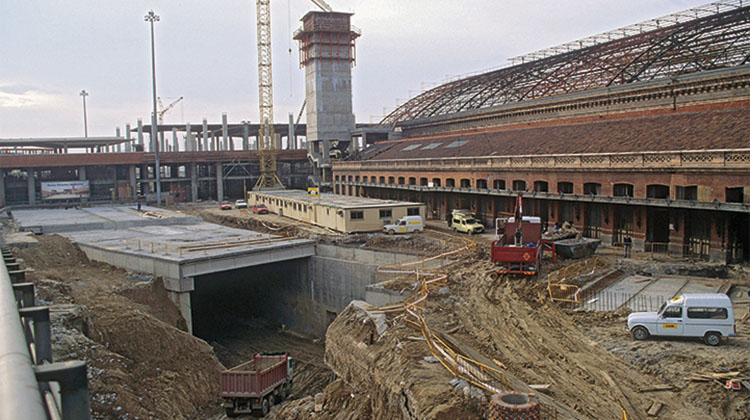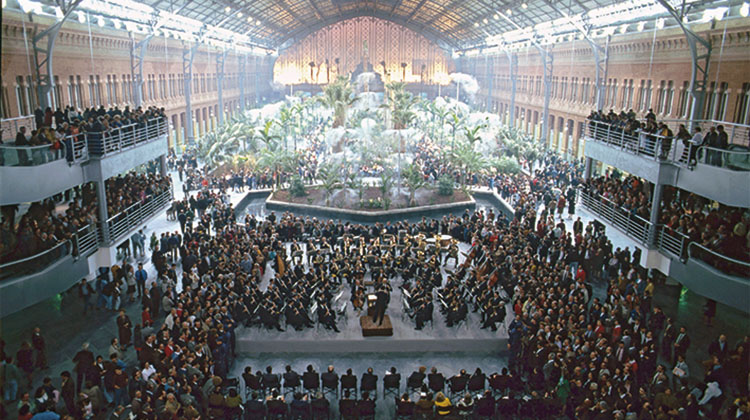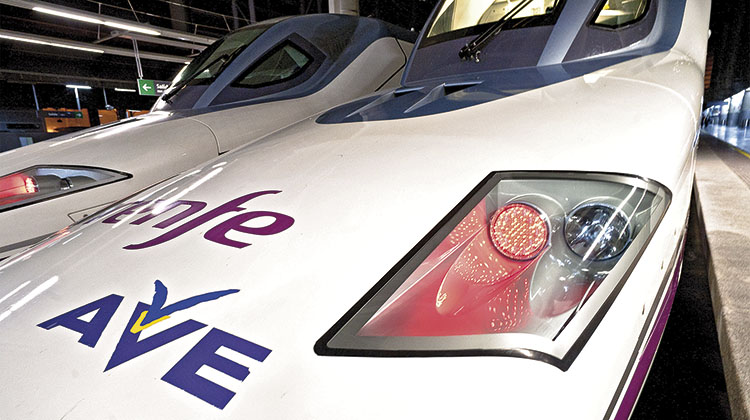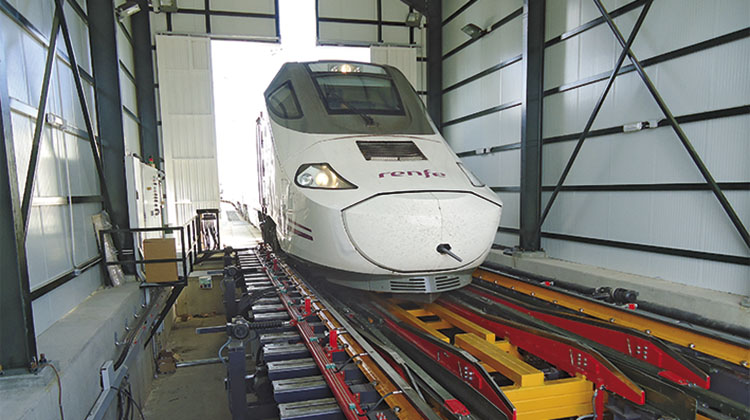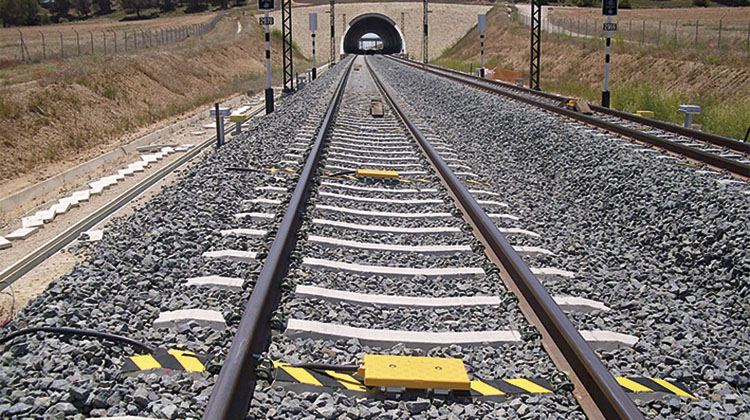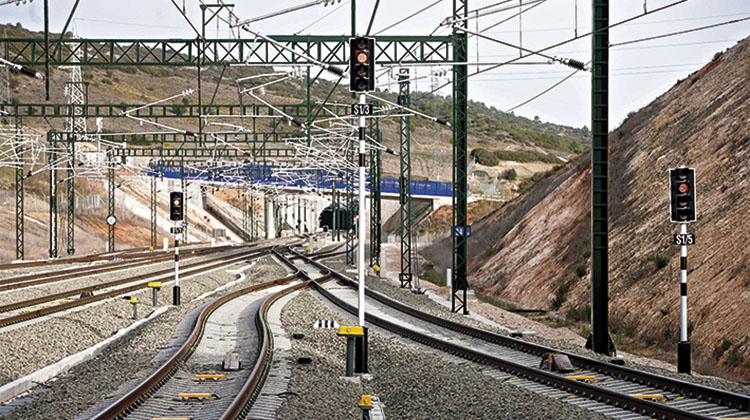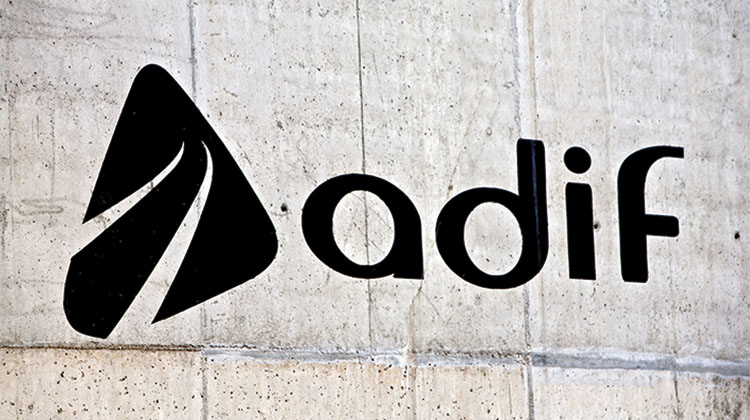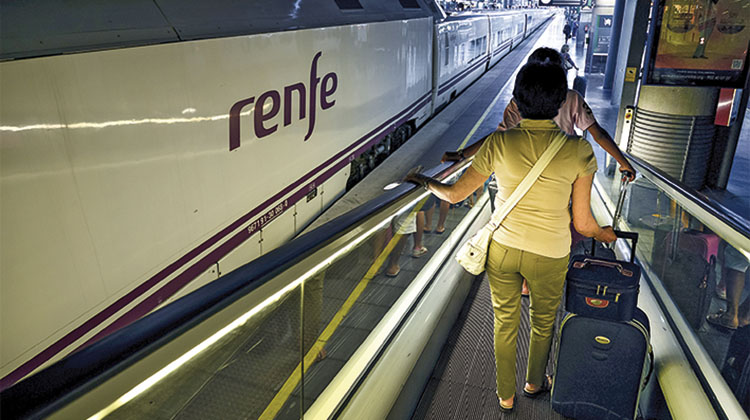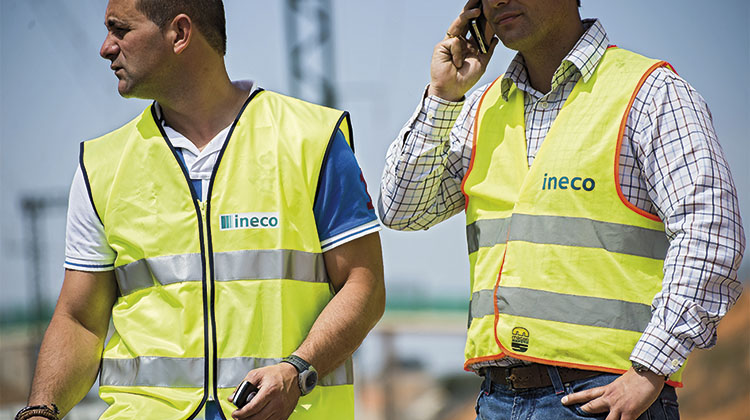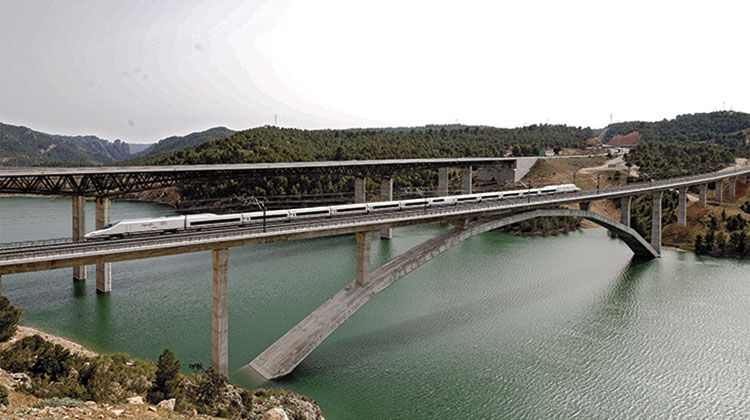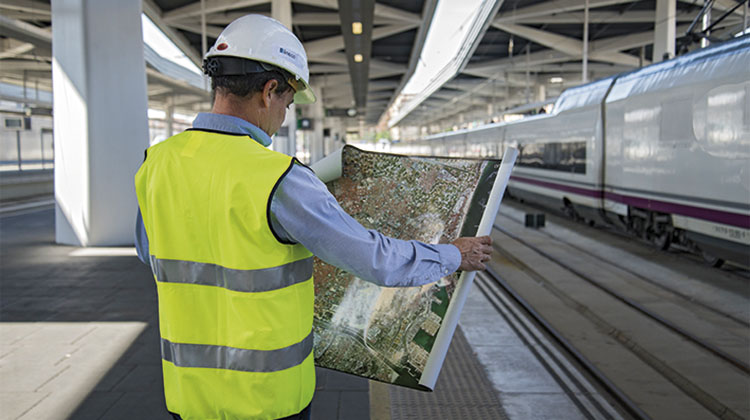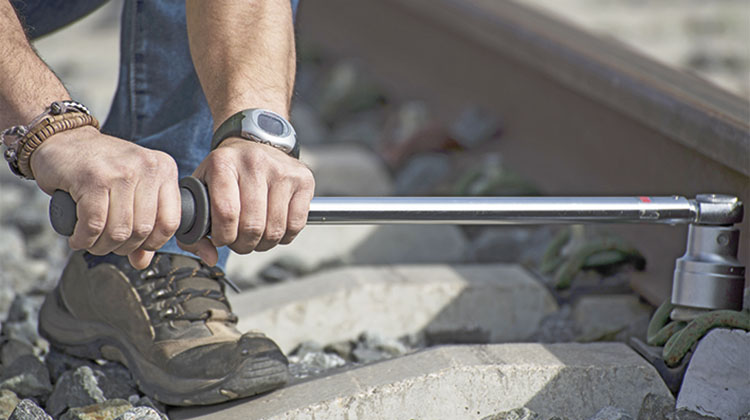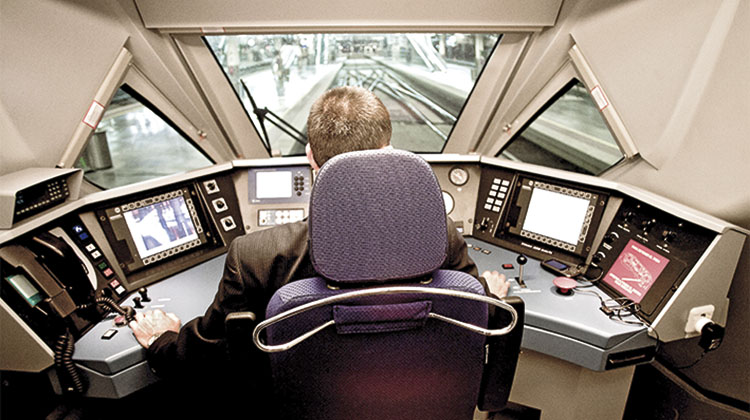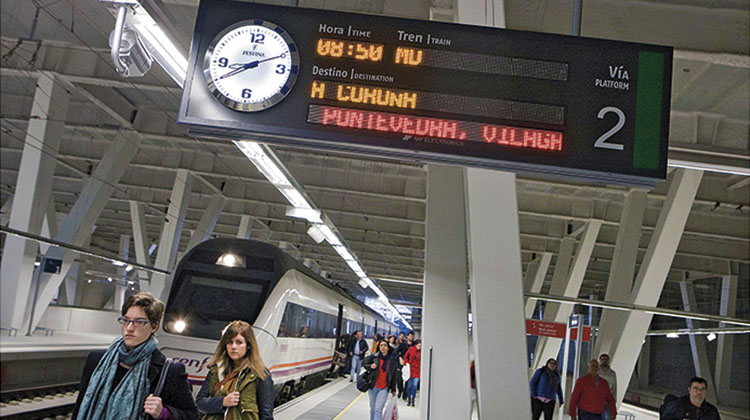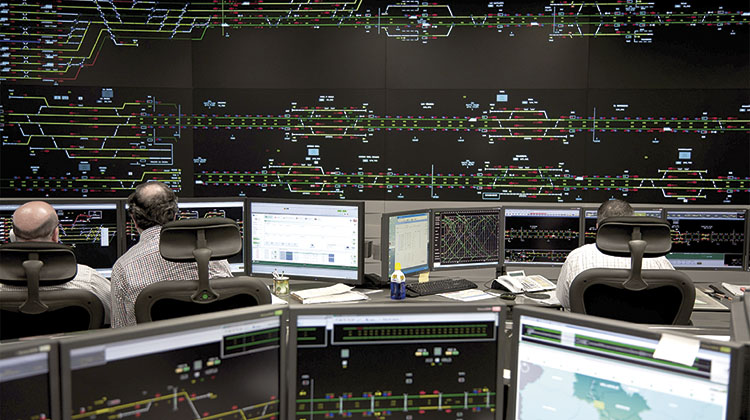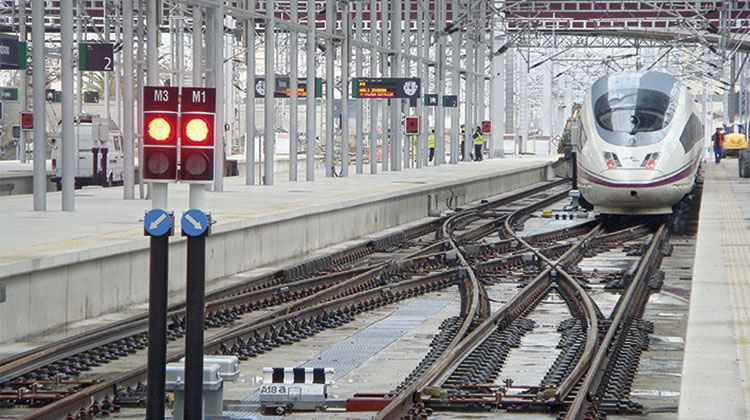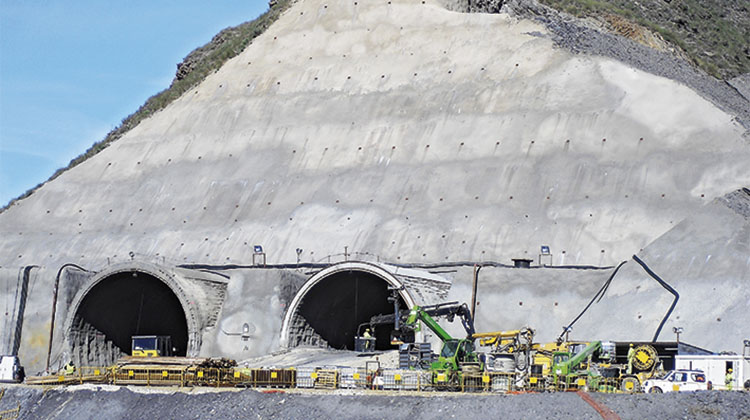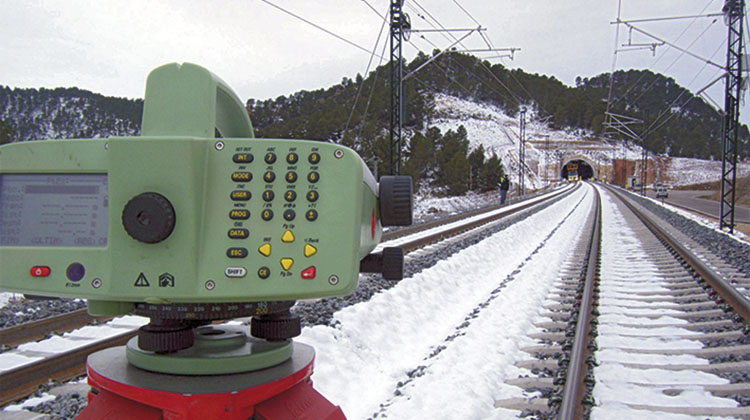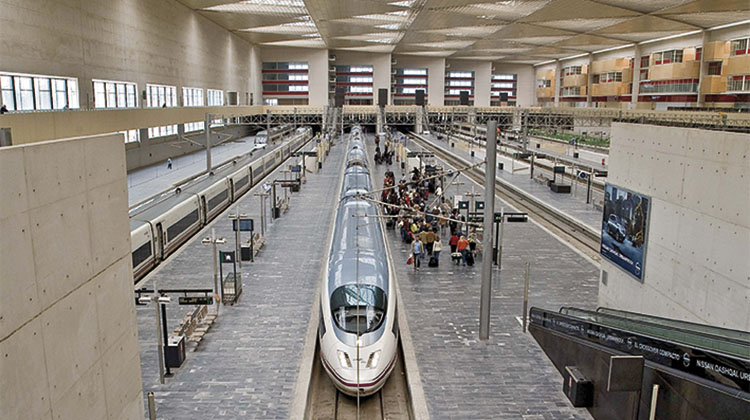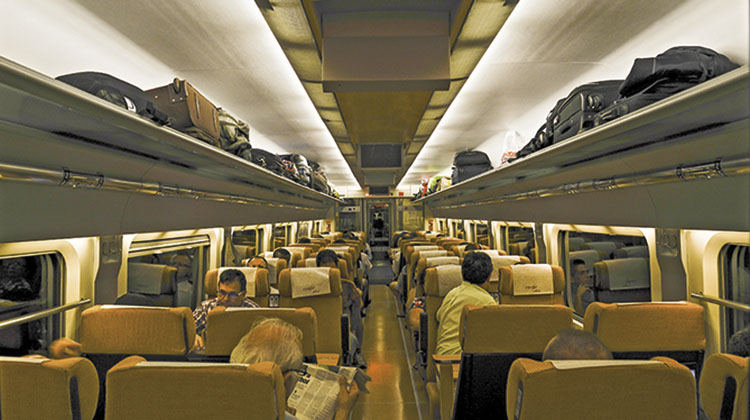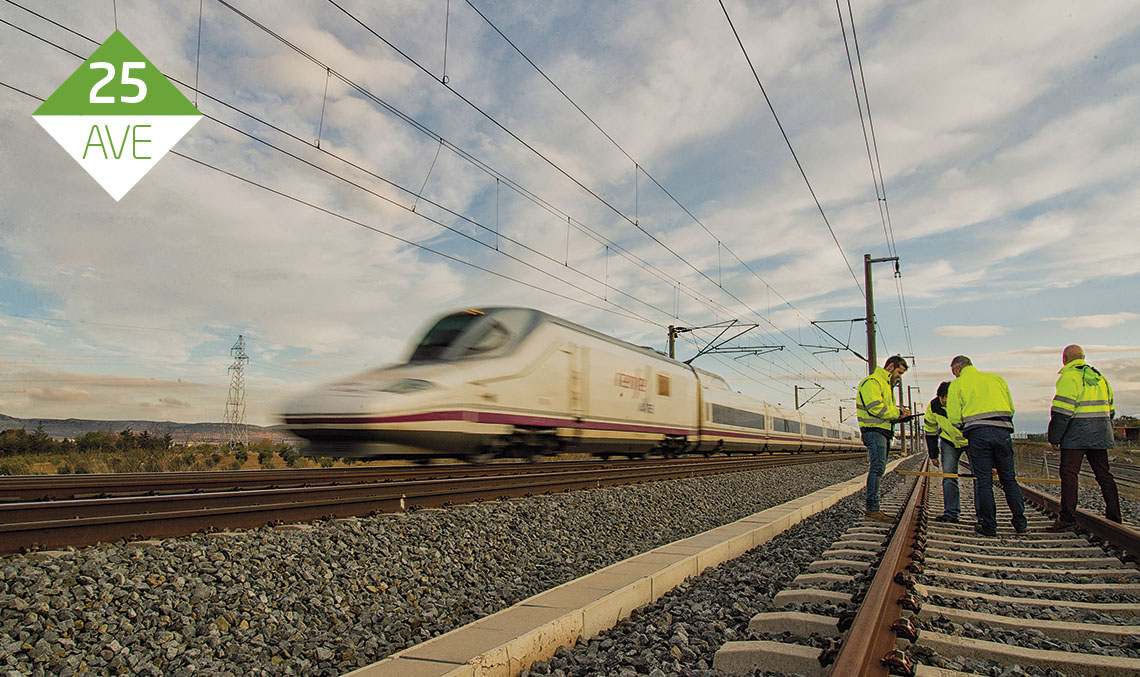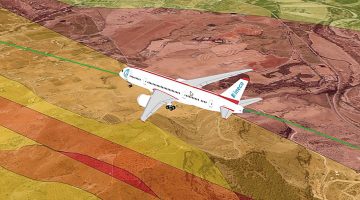The experience gained from those years on has been a starting point and guide for building the backbone of the country, and we now have the second most extensive high-speed network in the world. In this quarter of a century since the first line was opened up to the current network comprising over 3,100 kilometres in service, the experts of Ineco have acquired unique experience in designing and constructing high-speed lines. The level of technology attained by companies of the Spanish railway sector has attracted such worldwide recognition that the specific term AVE (Alta Velocidad Española, or ‘Spanish high speed’) was coined to refer to the experience brought. This is because the development of this railway technology –a major political objective of the governments of the last 30 years– has involved conditions and challenges incomparable with the histories of the few other countries that have embarked on this project (Japan, France, China, Italy, Germany, Belgium, the UK and, very recently, the USA), and overcoming these has driven Spanish companies to the highest level of expertise. We dedicate this report to the personal experience and memories of those who were with Ineco from the beginning, working closely with Renfe and the Ministry on successfully achieving this large-scale project.
25 years, 25 experiences
Spain was the fourth country in the world to take on high speed, after Japan (Tokyo-Osaka, 1964), France (Paris-Lyon, 1981) and Germany (Hanover-Würzburg, 1991). When in 1986 the government decided to build a high- speed line between Madrid and Seville, Spanish consultancy and engineering firms gave the best of themselves to make it a reality. In less than six years they managed to cover 471 kilometres in two hours and 50 minutes.
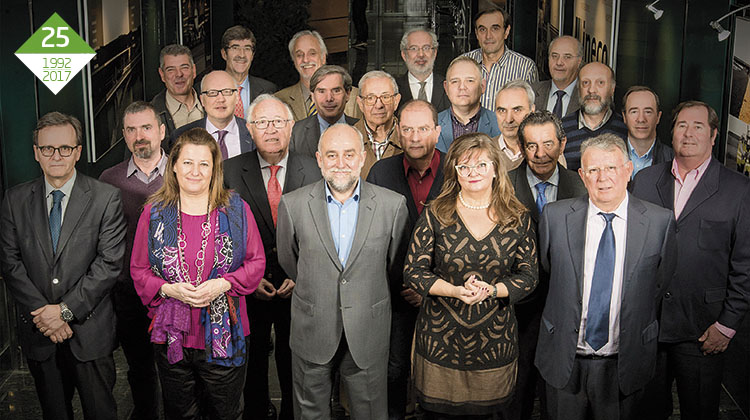
FAMILY PHOTO. A group of Ineco engineers and technicians worked to make high speed a reality in the 1980s and 90s. In the picture, a large number of them are at the entrance to Ineco’s headquarters in Madrid. / PHOTO_ELVIRA VILA
The opening on 20th April 1992 –after a record construction time– was scheduled to coincide with the Universal Exposition of Seville in 1992, and its challenge and aim were the economic development of Andalusia in the south of Spain. In the medium term, the government’s objective was much more ambitious: to build a new, modern railway network to be integrated with the future European high-speed network, a decision taken in the Council of Ministers in December 1988. As a product of this effort in innovation, investment and work, Spain ended the 20th century with the greatest transport engineering project, the first step in the radical change that has taken the railway network to the highest levels of efficiency and quality.
The speed with which the line was constructed –the work was performed over four and a half years– was related to the choice of route, which avoided the mountain pass of Despeñaperros, a traffic bottleneck from Madrid to the south of the Peninsula. In the search for alternatives, eight years earlier, in 1984, Ineco had conducted a study for Renfe on the economic and social profitability of a railway line from Madrid to Seville through Brazatortas-Córdoba. Two years later, on 11th October 1986, the government decided to prioritise the construction of this new railway access to Andalusia, named NAFA, which shortened the total distance by 100 kilometres. That same month Renfe entrusted Ineco with the execution of the preliminary and detailed designs for the main section, the Getafe-Córdoba stretch, 320 kilometres long with a maximum speed of 250 km/h.
In December 1986 a team was formed to carry out the work, creating a mixed office between Renfe, the Ministry of Public Works and Transport, and Ineco, so as to maximise its execution. From then until November 1987, a smaller group of engineers, draughtsmen and computer technicians began a frenetic race to carry out the preliminary and detailed designs for NAFA. Ineco directly completed 215 kilometres, and the best engineering consultants in Spain, such as Euroestudios, Intecsa, Eptisa and Iberinsa, were for the remaining 106 kilometres. All the infrastructure and track projects were undertaken and led by Ineco’s civil engineer, Jorge Nasarre y de Goicoechea. French firm Alstom won the contract to make the rolling stock (the trains) and the German consortium AEG Siemens was commissioned to electrify the entire Madrid-Seville railway line.
The opening on 20th April 1992 was scheduled to coincide with the Universal Exposition of Seville, and its challenge and aim were economic development of Andalusia in the south of Spain
On 5th October 1987, after delivering the initial projects, work began for the new Brazatortas-Córdoba line, a stretch of 104 kilometres named NAFA Sur (South). By the end of 1987, all remaining projects on NAFA were delivered, tendered and contracted. One year later the projects were modified to adopt the international track gauge, which is different from the Iberian gauge, with the intention that the new developments could be integrated into the European network.
At Renfe’s request, from April 1990 until the completion of the work, Ineco took part in quality control for the track to be accepted. The team of fourteen Ineco technicians led by civil engineer Ulpiano Martínez Solares, was advised by two German engineers sent by German firm DE-Consult (now DB), a subsidiary of the German railway company Deutsche Bahn. It is worth mentioning that both movable point frogs and those with a FAKOP solution, as well as the use of dynamic track stabilisers, were novel technologies in Spain. Today, our country is one of the leaders in designing and manufacturing these junctions. On the Madrid-Seville AVE we were able to improve the vertical stability of the track by levelling the land utilising techniques used in road construction. As regards lateral stability, Renfe’s technology was perfected by placing a pre-stressed or post-stressed concrete sleeper and elastic fastening, which enabled the rail to be soldered indefinitely. Additionally, using a 36 m basic rail –today, 90 m has been achieved– made it possible to considerably reduce discontinuities in the track in the form of electric welding.
Thanks to the knowledge acquired in the assembly stage, Ineco’s railway technicians got involved –after it was put into service in 1992– in track and infrastructure maintenance assistance, forming a team which today continues working for Adif on the Madrid-Seville line, on the Mora, Calatrava and Hornachuelos work bases. Ernesto Giménez and Santos López (together with Reyes García) continue working today on the Calatrava base; Alfredo Olivera, Francisco Rebollo and Juan Carlos Olivera on the Hornachuelos base; and Francisco Casasola and José María Melero on the Antequera base. Jesús Márquez Sánchez is currently working on the Extremadura high- speed line, Antonio Millán on the Villarubia base of the Madrid-Valencia AVE, and José Luis G. Sarachaga is assigned to the Vilafranca del Penedès base on the Madrid-Barcelona-French border AVE line. Rodolfo Velilla continues at Ineco as Maintenance Manager for the Madrid-Seville line and Manuel Corvo as a Senior Railway Expert.
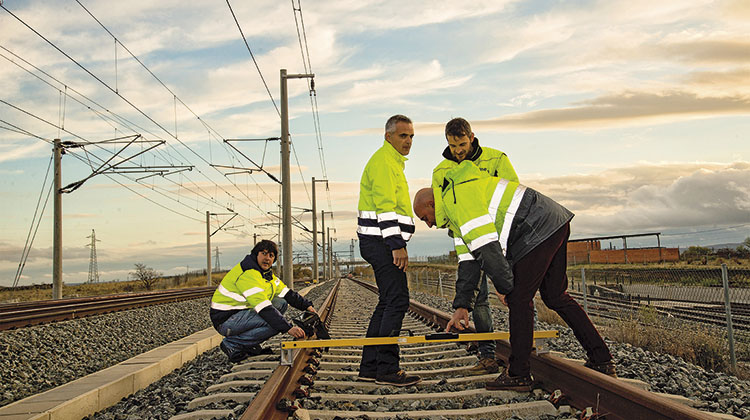
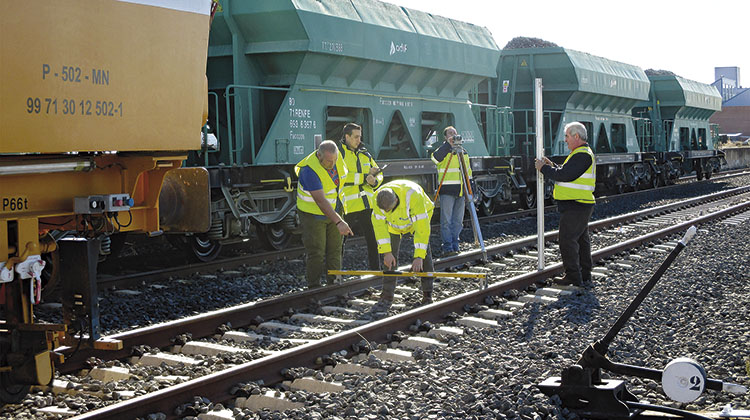
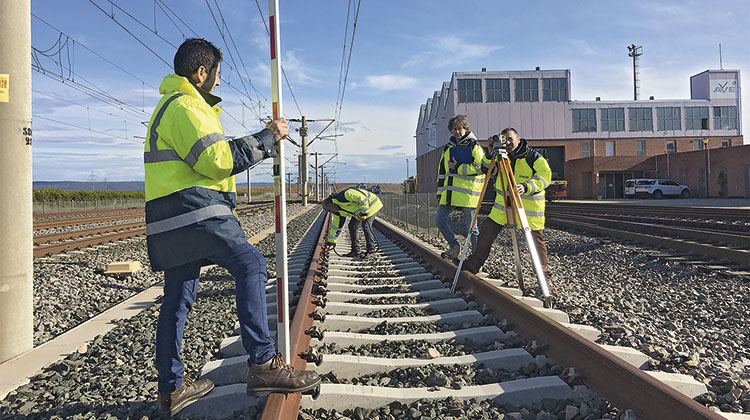
In December 1991, Ineco collaborated with the Spanish government to prepare the parliamentary appearances of the then Secretary of State Emilio Pérez Touriño on the imminent opening of the line. On 14th April 1992 a maiden trip was made in which part of the government, and representatives of Renfe and the Ministry, the consultancy firms and the Ineco projects drafting team travelled to Seville. The journey lasted two hours and 50 minutes. The success of the operation enabled the first commercial trip on the line to be made on 20th April.
From that year until today, high speed has been an unstoppable force, solving great challenges: the first, the extremely complicated orography of the Iberian Peninsula. With such uneven land, building infrastructure for high-speed trains to circulate on –speeds of 250-300 km/h require tracks with inclines no greater than 3%– involved executing tunnels and viaducts specifically for this kind of traffic, with demanding track platform parameters and rigorous technical specifications. Another remarkable –and no less challenging– aspect of the Spanish case was the use of high-technology equipments from various manufacturers, generating a large capacity for integration and development of various technologies. To this it should be added that the Spanish railway network had been built with the so-called Iberian gauge (1,668 mm), which is incompatible with the standard or international track gauge (1,435 mm) established for high speed and used in most European countries. This made it necessary to seek solutions such as the incorporation of the three rails to make circulation compatible on both gauges, the development of modern, fast variable gauge changeover facilities to change the Iberian to the international gauge, and track assembly adapting elements such as the ballast, slab track, sleepers and their clips, track devices, electrification, fixed installations, signalling, etc. Adaptation of the track gauge to international standards culminated in 2012 with the connection for the first time with Europe by the line between Barcelona and Figueres-Perpignan.
Completing a railway project of this magnitude and the technical disciplines this entails have enabled Spanish engineering and industry to be at the forefront in construction, installation, tune-up and maintenance of high-speed lines. From its technological definition and the first earthworks up to commissioning, a work without precedent was carried out. Practically the entire railway sector has been overturned over decades, becoming a long and complex process that goes from preliminary feasibility studies, informative studies, studies of demand, economic and financial analyses, environmental impact studies and civil engineering, electrification and signalling construction projects, to designs of stations and urban access operations, finishing with the supervision, construction, implementation, exploitation and maintenance of lines and all special works such as tunnels and viaducts.
As a product of this effort, Spain ended the 20th century with the greatest transport engineering project, the first step in the change that has taken the railway network to the highest levels of efficiency and quality
The technical and communication differences among European railway networks have been another hurdle to overcome. Isolated from Europe by a different track gauge, Spain was the first country interested in overcoming distances and pursuing interoperability with its neighbouring countries. Today, it is a leader in implementing the ERTMS, the European rail traffic management system that will enable trains to move freely throughout Europe by overcoming the technical and operational hurdles of each system and country through a common language.
The technical and legal expertise of Ineco’s technicians has led them to collaborate actively with the EU’s ERA agency on the process of harmonising European railway networks. After years of dedication, European signalling systems have been standardised, and signalling control points have been interconnected with this system. This and other services have enabled the acquisition of a high level of know-how in safety systems and communications, on-track detection systems and train protection systems. This experience was complemented by the design and construction of centralised traffic control centres (CRC), from which high- speed tracks are managed using the Da Vinci system, a Spanish patent exported to the United States of America, Morocco and Lithuania and used in the underground rail systems in London and Medellín.
In terms of rolling stock, in Spain there are trains in operation made by various manufacturers, among them those of Spanish companies Talgo and CAF. Consultancy and engineering firms have participated in railway operations with latest generation trains which incorporate high-performance technology, i.e. that which enables speeds of up to 350 km/h. Their implementation involves the participation of experts on circulation, reception of rolling stock and on-board equipment.
25 experiences
“I remember a herculean task of two weeks, weekends included, preparing the railway installations project for the section of the Madrid-Seville line managed by the Ministry of Public Works and Transport. This was my first contact with high speed”
Agustín Barriobero, telecommunications engineer
“What was in principle one railway line more (Brazatortas-Córdoba) became the source of a new railway and –I would go further– of a new mode of transport: high speed. First, the infrastructure and track projects; then the control: track, catenary, safety installations, and later maintenance, made us a benchmark company on a global scale in this field”
Juan Barrón, MSc in Civil Engineering
“Brazatortas –that’s what some called NAFA– was a challenge that was going to shape the future of railways. We began in 1986 tracing with templates on the paper map, and we put the finishing touches to it five years later, riding the train on the final test journey the day before opening. The tilting of the surface of the water in a glass on the table indicated to us that we were passing through banked curves. It was now a reality: we were moving at 250 km/h”
Pedro Benito, BSc in Civil Engineering
“The Madrid-Seville AVE project on rail traffic command and control was a turnkey project, in which the preparation of the Cerro Negro workshop safety installations project was lacking. After opening in April 1992, the line remained open in Córdoba with the famous level crossing, which closed when this station was moved underground with a safety installations project of Ineco’s”
Jesús Castillo, Jesús Castillo, industrial engineer
“For that project, a member of the draughtsmen team was needed, with the aim of maintaining Ineco’s standard in this field. Without thinking twice, I put my name forward for the task: that’s how things were done in those days”
Luis Colomer, draughtsman
“One of the fundamental advances was the use of geometric auscultation as the basis for global acceptance of the track and for its maintenance. The idea of dynamic auscultation, complementary to geometric auscultation, also began to be developed as a key element of railway maintenance. This conception of maintenance was exported to conventional lines such as the Levante, Mediterranean and Atlantic Axis corridors”
Manuel Corvo, senior railway expert
“In alternating current electrification in Spain, nobody had experience of the co-existence of the two systems (25 kVca and 3 kVcc) in a single site or station. With the advances achieved we were able to adjust their operation without leading to functional interference”
Adolfo Cruz, industrial engineer
“In 1986, I joined the NAFA team. We were very young, with Jorge Nasarre and Santiago Rallo in charge. Thanks to their expertise, we were able to draft the basic and construction projects for 320 kilometres in the record timescale of a year. We based it on the French model, adapting it to Spain’s orography and characteristics”
Marisa de la Hoz, BSc in Civil Engineering
“From the beginning I took part in drawing up and coordinating the projects for the stretches between Getafe and Córdoba, as well as Ciudad Real and Santa Justa stations. It was a great challenge, as Spain had no legislation on the necessary parameters for trains going at 250 km/h, which was achieved in less than 6 years”
Víctor Duarte, MSc in Civil Engineering
“I was involved in the design of Puerta de Atocha station, as part of a team responsible for drawing up the projects for the main stations. From those lively years, I remember the technical tools: pocket scientific calculators, templates of all kinds, scales, planimeters, frames, caulking tools, razor blades, etc. Classical draughtsmanship was our leading technology”
Santiago Espinosa, railway technician
“I joined Ineco as an expert in digital mapping for a project that was a big challenge in every way. Many hours of work, the odd sleepless night revising the calculations obtained by the new “programme”, headaches and a few nerves were finally worth it when the project succeeded. The best thing was the team and our teachers”
Dulce Galán, geomatics and topography engineer
“It was the first time digitalised mapping was used in Spain, an archaic GIS developed by a Spanish company. Two computers the size of industrial washing machines were used, the power of which was vastly inferior to the most simple smartphone we keep in our pockets today. The thousands of plans that comprise the project were printed on two pen plotters, which operated 24 hours a day as each plan took 50 minutes to print”
Víctor Gándaras, computer technician
“I joined Ineco –which was called TIFSA at the time– in 1988 with Manolo Guerrero, a wonderful professional, now retired. I found myself an enormous table full of plans of track devices… in German. These were going to be installed on the new high-speed line. We had to go to Germany a number of times to check their production. There were four of us providing technical assistance to Renfe. From then on to this day, lots of tracks, high speed, good experiences and great colleagues, in and out of Ineco…”
Moisés Gilaberte, MSc in Civil Engineering
“Along with Ulpiano Martínez and Rafael Herrera, we got into the field of superstructure control and new junctions. With the arrival of technicians like Rudolf Trenk from DB Consult, German technology was introduced to the high-speed sector. We visited all the work sites between Getafe and Villanueva de Córdoba; it was non-stop meetings and drillings and track devices. Finally maintenance was achieved and now 25 years have passed”
Ernesto Giménez, railway technician
“A catenary for 250 km/h? Powered with 25,000 volts? What is that? Working on the AVE line to Seville definitely opened the door for us to a part of Europe that was unknown for many of us. Today it is Europe and the rest of the planet who look to Spain as a reference in high speed”
Francisco Javier Guerrero, industrial engineer
“In a very short time it was possible to hire and train the entire team of the work bases to undertake a project that until then had not been done in Spain. Initially, we only controlled the superstructure. Then, the other disciplines were gradually included: infrastructure, electrification and safety installations. The bulk of this team remains at Ineco and has expanded its experience to the remaining high-speed lines”
Rafael Herrera, BSc in Civil Engineering
“When we got to Córdoba in 1990, we were entrusted with visiting ballast supplies to check their condition. Subsequently, various tests were performed to check that they met the specifications, which were quite strict, and especially that they passed the Los Angeles abrasion test. Today, I feel proud because the ballast continues to respond perfectly after 25 years”
Jesús Márquez, railway technician
The demands for high-speed precision are to the millimetre. That’s why I was so surprised when with the dynamic stabiliser, the track didn’t lose even a millimetre of levelling and alignment, and yet the ballast remained compacted. I had a lot of experience from working at Renfe and SNCF in the 1960s, but this was something very new, essential for moving at 250 or 300 km/h with no speed limits for stabilisation by loads after maintenance work”
Ulpiano Martínez, MSc in Civil Engineering
“I performed progress monitoring work for both the superstructure and track infrastructure, geometry quality drillings, geometric inspection and ultrasonics of aluminothermic welding, installation and control of track devices, etc. The experience I gained from NAFA enabled me to continue in line maintenance subsequently for 14 years”
Antonio Millán, railway techni-cian
“The beginnings of high speed in Spain were a complicated birthing process. These are the words of Elías García González, one of the best railway engineers in Spain in the last third of the 20th century, my teacher, and an irreplaceable technical support (for example, in defining the free section for aerodynamic effects of tunnels) in conceiving the first project (Getafe-Córdoba). The Spanish railway in the 21st century owes much to him and to Ineco’s reduced collaborating team”
Jorge Nasarre, MSc in Civil Engineering
“We started working on monitoring the assembly of the superstructure between Córdoba and Seville in the mid-1990s. There were still structures left to erect and, on some stretches, the ground wasn’t levelled. What we did have, though, was a deadline: April 1992. We thought we wouldn’t have time or we wouldn’t meet the quality standards required to operate at 250 km/h. The general comment, even among lifelong railway experts, was: “I’ll believe it when I see it”. Then April ’92 arrived and we saw it… and we believed it”
Juan Carlos Olivera, railway tech-nician
“My first significant contact with the Madrid-Seville line was in 1984 from the company Intecsa, where we carried out the platform and track construction projects for Ineco on the stretches between Brazatortas and Villanueva de Córdoba. This stretch, which was initially designed for 160 km/h, had to be updated to a speed of 250 km/h, which meant all the projects had to be changed completely”
Esteban Rubio, BSc in Civil Engineering
“There were only 20 of us and we were given the task of drawing up the plan for adapting a few stretches between Córdoba and Seville. My contribution was the assist in measuring the units and scraping plans, which were drawn in ink on tracing paper. Then I worked on other projects, from tunnels to trams, and then again on high speed with the Madrid-Barcelona-French border line, in which I fully participated, and many others in Spain and abroad”
Roberto Salas, BSc in Civil Engineering
“I took part in quality control for the Córdoba-Seville stretch, which together with the NAFA project and control and supervision of the ballast and junctions, were the precursors to the large operation Ineco undertook on the high-speed lines in Spain and others abroad such as in Turkey, Saudi Arabia and the UK. Its success was based on the working capacity of Ineco’s young engineers and the experience and expertise of Renfe’s technicians, and future success will be achieved by being competitive”
José María Urgoiti, MSc in Civil Engineering
“We managed to get that project off the ground with acceptance criteria that were exceptional for that time, such as track inspection vehicles, as well as geometric and ultrasonic control of each and every aluminothermic weld conducted in situ. Once the line had opened, Ineco participated in the design, management and development of the high-speed maintenance model, which ADIF continues to use today”
Rodolfo Velilla, senior technical expert
25 years in pictures
